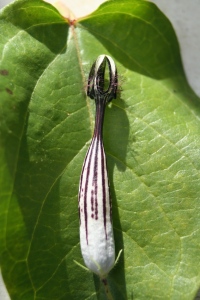A very rare tuberous-rooted species that grows in Zimbabwe. The only part of this plant that is actually succulent is the tuber, the rest is non-succulent growth. The stems are thin and hairy, the leaves are heart-shaped without any hairs on. The flowers are pollinated by small flies of various species; size being the important qualification and not the particular species of fly as the plant is pollinated over here by different flies from the ones they have in Zimbabwe. When pollinated, seed horns are formed of about 10 cm. Make sure you catch the seed before it is released, otherwise you will lose it. The seed should be sown within half a year of collecting, preferably earlier, because it has a limited shelf-life. The seeds can germinate within 24 hours if sown under plastic and kept moist. It will form a reasonably-sized tuber and flowers in the first year of growth.
The plant should be kept in a warm greenhouse (minimum 15°C). In the winter the tuber has to be kept dry, otherwise it will rot. The plant prefers an open soil with good drainage.
Ceropegia meyeri is very rare in cultivation, partly because seed is hardly ever available and the plant is not so easy to propagate from cuttings. It is possible to take cuttings, however, but you need a high temperature (25-30°C) and a high humidity. As with most other tuberous-rooted ceropegias, unlike some other caudex plants (e.g. Adenium obesum), a plant grown from cuttings will develop a tuber. The plants climbs through other plants, using them as support.

April 21, 2016 at 9:30 am
This is not C. meyeri but C. bonafouxii: the obvious difference is the shape of the cage which is distinctly wider than long in C. meyeri, not cylindrical and longer than wide as in the corolla illustrated
April 26, 2016 at 7:11 pm
Quite possibly. I bought the seeds from Silverhill Seeds, SA, as meyeri, so that is why I have named it as such, but the cage is indeed longer, so could very well be bonafouxii. Thanks!
February 10, 2015 at 12:16 am
Reblogged this on Klarinet.